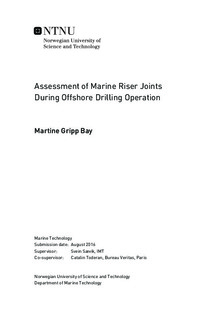| dc.description.abstract | Riser technology is pushed to its limits as the demand for deeper drilling operations increases. There exist no standards for the mechanical assessment of marine riser joints today, however new standards are under development at TH HILL, a Bureau Veritas enterprise in Texas. The work in this thesis focuses on parts of the development work, more specifically creation of a methodology of the riser and riser joints, with respect to strength and fatigue.
A documentation of the existing technology for riser and riser joints has been presented in this thesis, and it includes an overview of the available products in the industry and standards of riser components and analysis methodologies. Theory of the drilling riser system and the different analysis, have also been presented in the thesis.
The global load analysis and fatigue analysis are carried out with Flexcom. The vortex-induced vibration analysis is performed through an interface between SHEAR7 and Flexcom. The second order vessel motions are calculated with Ariane. The methodology is developed based on one case study, and the input data for the geometry is based on the documentation on the existing technology. All input data have been carefully selected and discussed with employees from different sections at Bureau Veritas, who holds a broad industry experience within the field. Based on these discussions, a number of sensitivity studies and investigations have been conducted. This include definition of boundary conditions, current direction, wave effect, application of second order vessel motions, simplified second order vessel motions and stress concentration factors. From these investigations, a final analysis model has been established and one combination of current, wind and wave direction has been investigated.
The final analysis model consists of current, waves and second order motions. The current velocity is 1.13m/s and the wind velocity is 22.5m/s. The current profile is based on a combination of an internal metocean report from Bureau Veritas, and the API standard Interim Guidance on Hurricane Conditions in the Gulf of Mexico. The riser is connected to the vessel, which limits the significant wave height to 6m. The irregular waves are applied with a JONSWAP spectrum and the second order vessel motions are calculated based on a dynamic positioning system with maximum offset of 20m. In the global load analysis in Flexcom, yield and buckling have been investigated. The worst sea states have been selected based on the resultant moment for a 1-hour analysis. The effective tension, bending moments and shear force, have been studied for a 3-hour analysis. Fatigue from waves and current have been investigated in two separate analyses. The fatigue analysis in Flexcom investigates the affect from waves by use of three cycle counting methods, i.e. rainflow, spectrum and statistics. The vortex-induced vibration analysis investigates the effect from current, based on the eigenvalue analysis in Flexcom.
The results from the worst sea states in the global load analysis showed that the highest moments occurred at the bottom and at the top of the riser. Sea state 8, with Hs=6m and Tp=11.5s, gave the highest moment at the bottom, and sea state 6, with Hs=6m and Tp=9.5s, gave the highest moment at the top of the riser. The standard deviation was largest at the bottom of the riser, and the shear force was highest at the top. The effective tension showed that a small part of the riser was in compression, but this has been neglected due to the results from hand calculations.
The results from the fatigue analysis showed that the damage due to waves, was close to zero for all sea states. Flexcom calculates the damage with an accuracy of 1.0E-5, so hand calculations of the damage for selected sea states was therefore carried out. From the analysis with stress concentration factor 10, sea state 6, 5 and 4 showed a reduction in lifetime at the bottom and at the top of the riser. The highest damage was at the top of the riser. A stress concentration factor equal to 10 is most likely unrealistic, but it showed that Flexcom performs fatigue calculations. The rainflow counting method gave the highest damage on the riser, compared to the statistics and spectrum methods. The analysis with no second order vessel motions gave also almost zero damage, and the results were exactly the same as the analysis with second order vessel motions. Based on these results, the complexity of the methodology can be reduced by excluding the calculations in Ariane. The results from the vortex-induced vibration analysis showed that the damage due to current was highest at the bottom. The damage was, however quite low over the whole riser. With a stress concentration factor of 9, the results showed significant damage of 0.47, at the bottom of the riser.
Based on the results from the different analysis, the potential of the methodology is shown, and it can hopefully be a useful tool when developing new standards for deeper water depths. | en |

